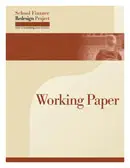Policymakers and researchers alike have expressed concern about a teacher quality gap between schools with affluent student populations and the more disadvantaged ones. There appears to be growing policy interest in using financial incentives to influence the distribution of teachers across schools.
A significant body of empirical research shows that compensation and working conditions both play important roles in individuals’ labor market decisions. One methodology for calculating compensating salary differentials (“combat pay”) is to use hedonic modeling, a statistical methodology that assigns dollar weights to the factors (both teacher-specific and location-specific) that determine individual teachers’ salaries. However, the hedonic approach may not generate consistent or accurate results in the public sector.
This study uses teacher and school-level data from the NCES Schools and Staffing Survey combined with census-level information about community characteristics to build hedonic wage models for both public and private schools. The key variable of interest was the percentage of students qualifying for free/reduced-price lunch, but other student characteristics, such as academic ability and race, were also taken into account.
Both public and private sector schools appeared to compensate teachers for some working conditions. Statistically significant differences between the two models, however, suggest that that public and private schools offer different economic returns to working with disadvantaged populations. In the case of a female teacher choosing between schools in the 25th and 75th percentiles of student income, the difference in “combat pay” between public and private schools is substantial—almost $2,500.






